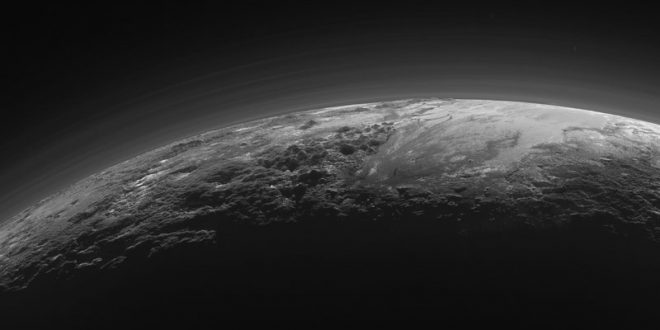The planet Pluto has a semi-solid ocean and it lies directly beneath its crust.
In the newest issue of Nature, a team of American scientists present the analysis of new data collected by New Horizons to illustrate the likely role a subsurface ocean had played in helping to shape a geological plain on Pluto known as Sputnik Planitia. The 1,000-kilometer wide, heart-shaped basin is one of the most famous features of the planet. The new study suggests the accumulation of ice created enough weight to cause the planet to literally roll over and reorient itself.
Sputnik Planitia is strangely aligned with Pluto’s tidal axis — making it very likely that the basin possess a big amount of extra mass under its surface that would help facilitate such a dramatic planetary reorientation.
“It’s a big, elliptical hole in the ground, so the extra weight must be hiding somewhere beneath the surface,” said Francis Nimmo, professor of Earth and planetary sciences at UC Santa Cruz and the lead author of the new study, in a news release.
A second study, led by University of Arizona researcher James Keane and also published in the same issue of Nature reaches similar conclusions and points to fractures in Pluto that a subsurface ocean is probably at fault, so to speak.
It’s pretty rad stuff, but mentioning “ocean” and “planet” in the same line of text always leads to one bigger question: what does that mean for the prospects of life on the planet? After all, the subsurface ocean we’re talking about here would presumably be made of liquid water — and water is always a plus for the prospects of habitability on other worlds.
That speculation runs on a double-edged sword. Pluto is still a dwarf planet that resides in a really obscure part of the solar system — really far from anywhere we would expect life to possibly evolve. Nevertheless, New Horizons has shown us that it’s a surprisingly active world. “That the movement of volatiles and shifting ice around a planet could have a dramatic, planet-moving effect is not something anyone would have predicted,” said Keane, in a separate news release. We might very well run into more surprises that suggest Pluto, or planets with similar characteristics, could in fact possess the ingredients to allow extraterrestrial life to survive.
Agencies/Canadajournal
 Canada Journal – News of the World Articles and videos to bring you the biggest Canadian news stories from across the country every day
Canada Journal – News of the World Articles and videos to bring you the biggest Canadian news stories from across the country every day



